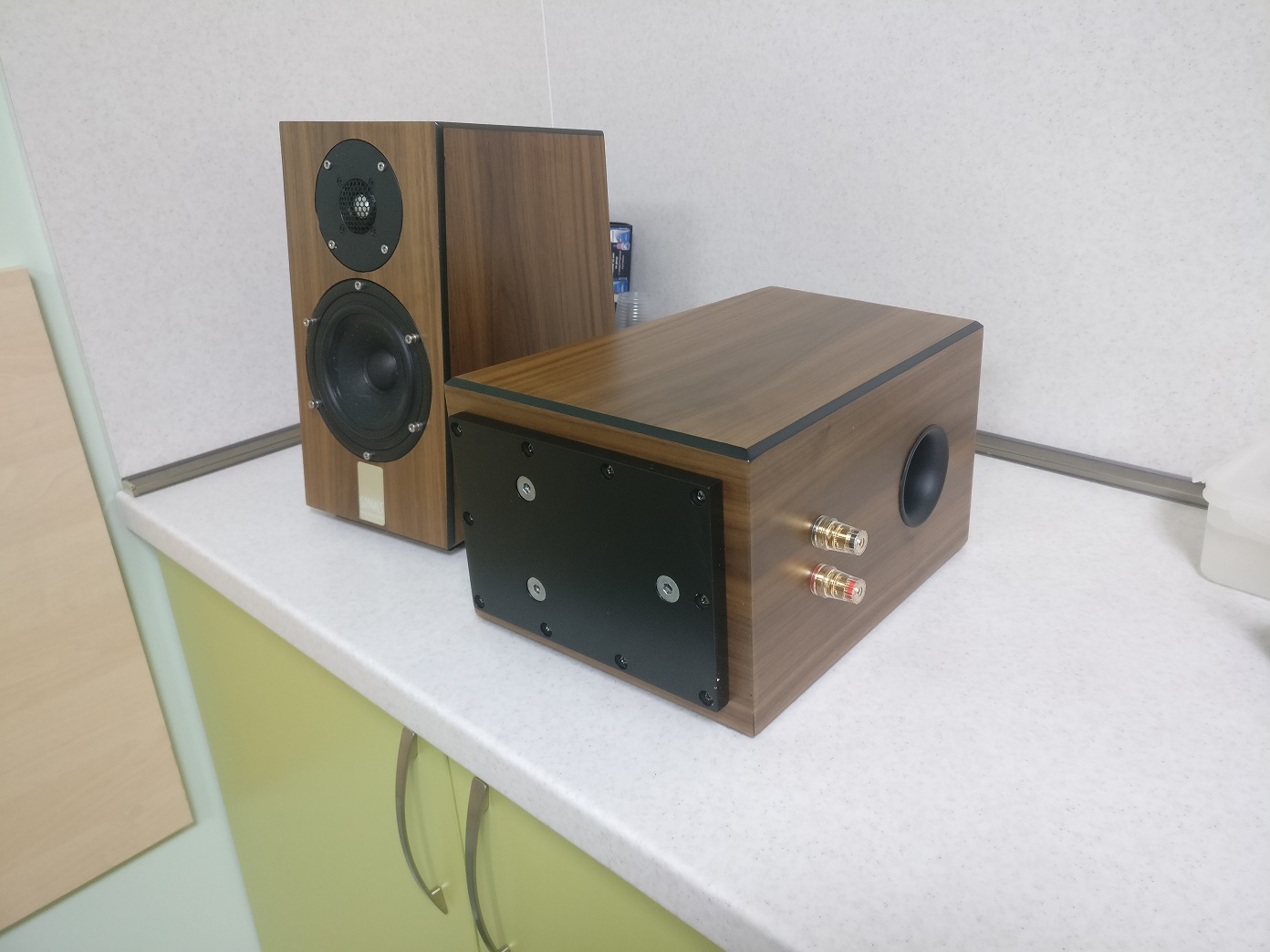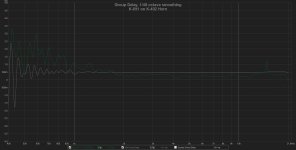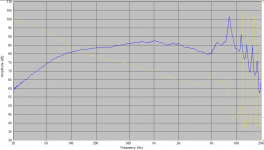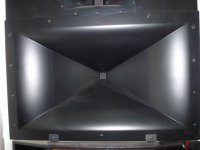Bit of a weird post, TNT... 😕
Are we talking about Joachim Gerhard's Animas here?
The review is at Stereophile: Sonics Anima loudspeaker | Stereophile.com
He used these unlikely looking metal drivers, both with huge breakup:
SEAS L15RLY/P
SEAS 22TAF/G
I didn't know he also offered the Nextel version:

That's this one: SEAS ER15RLY
TBH, I would prefer the altogether safer paper cone:
SEAS CA15 RLY
The breakup problems just make more work IMO, but it's interestimg how the midbass drivers evolve as we increase the cone damping.
Are we talking about Joachim Gerhard's Animas here?
The review is at Stereophile: Sonics Anima loudspeaker | Stereophile.com
He used these unlikely looking metal drivers, both with huge breakup:
SEAS L15RLY/P
SEAS 22TAF/G
I didn't know he also offered the Nextel version:
That's this one: SEAS ER15RLY
TBH, I would prefer the altogether safer paper cone:
SEAS CA15 RLY
The breakup problems just make more work IMO, but it's interestimg how the midbass drivers evolve as we increase the cone damping.
You are showing breakup, that it exists at least. The presence of resonance is probably generally known, but resonance can be damped, if it is of a simple enough nature. Cone breakup probably isn't that simple, at least it cannot be undone by equalisation.as viewed in the time domain.
I agree that is the point you are making here, but again..?Unfortunately, it's not the horn effects that's creating the breakup modes seen but rather diaphragm break-up modes.
I'd be inclined to accept this anecdote. After all, there may be different source directions.even very low values of GD above 10 kHz--associated with diaphragm break up--are quite audible.
Ringing as in a resonance, lets say one with a single source should be minimum phase. It should sit at the same place with regard to group delay considerations.what is the timing reference with which to calculate phase/GD when there are multiple pulses due to diaphragm "ringing"?
I have no great theories about how much group delay is audible. I suspect the associated distortion is a much worse pest.
This video about ribbons is fascinating. I like Ryan and what he does in the Impulse Audio channel. YouTube
I think this is the video where he plays guitar to convince you 3rd harmomic distortion is much more annoying than second. IIRC, 3rd harmonic comes from asymmetric frequency response, but I might be wrong there.
But I just look at that $500 ribbon GRT 145 waterfall and say cross over above 4.5kHz! No brainer. 😀
FWIW, the GRT is unusual amongst ribbons in having a surround. Maybe that explains its rather good control at low frequency. Well, better than most ribbons.
Yes. The "surround" will give much better lower freq control, BUT it is likely responsible for much of the hash below 4k as well as the shelf down. The half roll polyester film surround results in a rigid beam along the sides of diaphragm.
Last edited:
Its a common mistake to just look at a frequency response and think you know what it sounds like. A particular pattern (like that of a metal driver in break up) might sound worse because your brain interprets the pattern as being metal.
A lot of people have subjectlvely developed preferences for different materials even though the objectivists say the material doesn't affect the measurements that much. But its not the measurements that matter most, but how our brain interprets them.
A lot of people have subjectlvely developed preferences for different materials even though the objectivists say the material doesn't affect the measurements that much. But its not the measurements that matter most, but how our brain interprets them.
Last edited:
I agree. Once a driver goes into breakup, it is finished. There is nothing in the way of useful output to be had. All you can do is roll off the breakup as much as possible.
I said earlier that 8" drivers breakup up at 3kHz. 6" at 5kHz. 4-5" around 7-8kHz. Even a fullranger does not defy this rule.
Visaton have recently introduced a rather splendid pricey 4" fullrange:
B 100 - 6 Ohm | Visaton
But I'd use that as a mid. You can see why it is problematic above 7kHz. The CSD shows the stored energy, aka breakup. More manufacturers should publish the waterfall, IMO. It is particularly revealing for tweeters, and often shows the useful crossover point below which things go to hell.
3 khz for an 8" driver? There is no accepted definition for what break up is, but that sounds too high.
Look at the seas excel 7". I don't own it but based on my experience I would start rolling that off to a mid by 500 hz. I'm sure it would sound holographic up to that point.
SEAS Excel W18EX-001 (E0017) 7" magnesium Cone Woofer
3 khz for an 8" driver? There is no accepted definition for what break up is, but that sounds too high.
Look at the seas excel 7". I don't own it but based on my experience I would start rolling that off to a mid by 500 hz. I'm sure it would sound holographic up to that point.
SEAS Excel W18EX-001 (E0017) 7" magnesium Cone Woofer
Steve is talking about breakup (rising frequency response at the top of the frequency range where the driver naturally rolls off) - not crossover point.
I am crossing the Seas L15RLY/P ~ 2KHz and have a bit over 4th order acoustic slope - and that still requires a notch filter to tame the breakup towards the top of the passband with the tweeter.
Playing the L15 alone on a variety of music reveals no harshness / stridency.
I know Joachim with his Animas crossed over a bit higher ~ 2.7KHz.
A rule of thumb I've read is cross over >=2 octaves away from the primary breakup node on metal / hard coned drivers. Watch for the odd order harmonics as they will be attenuated commensurate with the primary breakup being attenuated.
One of my L15s breaks up at 8,224Hz (reminds me - I should measure the other one 🙂.
First attachment is the raw L15, 2nd with crossover. Note the dual notch (0.22uF series and 7.47uF with 0.05mH no resistor parallel) to achieve the required steeper acoustic rolloff.
Attachments
A rule of thumb I've read is cross over >=2 octaves away from the primary breakup node on metal / hard coned drivers. Watch for the odd order harmonics as they will be attenuated commensurate with the primary breakup being attenuated.
Two octaves from break up seems about right, but it all comes down to sound. If it sounds colored then its too close to break up. A heavily damped metal cone is behaving more like a composite material and could work with a higher crossover point.
The dispersion is usually pretty bad around break up anyways, and many tweeters can cross below 2k hz.
This ceramic driver looks well behaved till 4K, which is impressive but the FR could be hiding some greak up issues earlier.
SB Acoustics SB17CAC35-4 6" ceramic woofer
Last edited:
Not an unusual find at these relative frequencies. Is this a picture of the 402? is it a 2" throat?I'm referring to the 14.83 kHz bump in group delay below.
It clearly hasn't been designed for higher frequency duty (using commonly available compression drivers, though it would be fine with the right source..) but it should be quite fixable. Maybe bring it back at the throat a little more OS like while blending the cross sectional shape. I'd assume you're good with the 2" driver although taking this down to 1" may open opportunities in terms of construction, and maybe offer drivers of different phase plug design? ..I use 1" down to 700Hz.
Attachments
Last edited:
Your advice seems to conflict sharply with the advice and insights that I've gathered through direct conversations (in person and ongoing tutoring) over the past 11 years with Roy Delgado, Klipsch Professional lead engineer and Paul Klipsch's engineering protégé.
Could you describe your background designing loudspeakers and/or which models you've designed?
Chris
Could you describe your background designing loudspeakers and/or which models you've designed?
Chris
My suggestion was based on observation in consideration of the group delay anomaly (at this high frequency). I wouldn't venture a subjective view on such little information.Your advice seems to conflict sharply with the advice and insights that I've gathered
Over 40 or so years it would be quicker to list what I haven't done. I wrote my own comprehensive crossover design software some 30 years ago, room modeling software, and displaced horn wavefront combining software for crossovers. In the past 10 years I have focused on waveguides, horns and in particular, corner speakers.Could you describe your background designing loudspeakers and/or which models you've designed?
If you accept that distortion is a function of excursion and non-linear mechanical losses, this seems to work. I am sure it's not the liveliest or most detailed of sounds, but nothing offends on complex music like orchestra.
But does it turn to sonic mush? Do instruments maintain separation? Can you tune your ear into each section and focus your listening if you choose? or does one section blend in with the other?
Not offensive = missing out to me. I want to have both easy listening and detailed / analytical / clinical at the same time (or at least switchable).
...It clearly hasn't been designed for higher frequency duty (using commonly available compression drivers, though it would be fine with the right source..) but it should be quite fixable. Maybe bring it back at the throat a little more OS like while blending the cross sectional shape. I'd assume you're good with the 2" driver although taking this down to 1" may open opportunities in terms of construction, and maybe offer drivers of different phase plug design? ..I use 1" down to 700Hz.
The reason I asked about your experience designing full loudspeakers is that you're apparently ignoring the effect of your recommended actions on the resulting loudspeaker performance in order to achieve something that is "locally optimal but globally suboptimal". These system level goals are important assumptions that we must share in order to achieve a tacitly stated but mutual goal. Otherwise we're merely talking past each other and are not actually communicating at all.
I don't agree with your observation or any of your recommendations in the above quote--and for various reasons, not the least of which is because you're apparently not reading very closely or integrating conversations that we've had over some time (the duration being measured in years). It's as if we're presently not communicating at all.
[This is of course diverting answering the OP's question. My apologies.]
I see this happening quite often in diyAudio circles. It generically goes something like this: some local performance issue is identified and brought forward as if it is "the" problem, and certain design or fix-it trades ensue which wind up compromising the entire design, completely out of proportion to that difficulty's contribution to solving the overall system problem being developed. It winds up driving the entire design performance out the window--but curiously, everyone seems to be otherwise happy to express what they wish nevertheless.
Chris
Last edited:
Chris,
With all due respect, I have completely lost you. As far as I understand you only focus on a 14 kHz issue, based on a low res spectogram plus associated GD plot. From what I understand from your writing, you draw far reaching -subjective/soundwise- conclusions from that about less then satisfactory sound reproduction.
When Allen stated throat coupling might be an issue -btw I suggested more or less the same thing-, you divert the discussion and seem to start an Ad Hominem argument.
Why not discuss throat coupling and throat prophile? Show us a COMSOL BEM simulation about the perfect coupling of the K402 and the K-691 driver, so we can rule out imperft driver-horn couplinga s the source of 14kHz trouble. Maybe you could convince the participants in this thread that way.
How does all that relate to globally optimized loudspeaker design?
Eelco
With all due respect, I have completely lost you. As far as I understand you only focus on a 14 kHz issue, based on a low res spectogram plus associated GD plot. From what I understand from your writing, you draw far reaching -subjective/soundwise- conclusions from that about less then satisfactory sound reproduction.
When Allen stated throat coupling might be an issue -btw I suggested more or less the same thing-, you divert the discussion and seem to start an Ad Hominem argument.
Why not discuss throat coupling and throat prophile? Show us a COMSOL BEM simulation about the perfect coupling of the K402 and the K-691 driver, so we can rule out imperft driver-horn couplinga s the source of 14kHz trouble. Maybe you could convince the participants in this thread that way.
How does all that relate to globally optimized loudspeaker design?
Eelco
Chris, If I suggest a direction and then list all the potential compromises and solutions that would be presumptuous, wouldn't it 🙄
I just happen to be having a quiet beer, texting with my children and enjoying some techno chat. Why can't your throat treatment be done without making things worse?
I just happen to be having a quiet beer, texting with my children and enjoying some techno chat. Why can't your throat treatment be done without making things worse?
So what kind of measurements would relate to the severity of cone break-up? There must be some measurement related to every auditory phenomenon, right?
This is the question, right? I've actually focused on answering this with real plots and discussion of those plots.
What subject are you guys discussing?
Chris
By the way, the breakup of the diaphragm motion above 10 kHz in the drivers that I've got data on is well documented and non-controversial--which is why I picked them. Why suddenly this is now "subjective/soundwise" and "presumptuous" is a mystery--or perhaps not..if you are trying to steer the discussion away from the question the OP asked.
If anyone has measurements/plots (i.e., not "pictures") of something that's closer to the OP's driver, I'm ready to see them.
Chris
If anyone has measurements/plots (i.e., not "pictures") of something that's closer to the OP's driver, I'm ready to see them.
Chris
- Status
- Not open for further replies.
- Home
- Loudspeakers
- Multi-Way
- Cone break-up - how to quantify with measurements?



